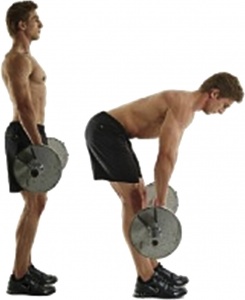Romanian deadlift: Difference between revisions
No edit summary |
No edit summary |
||
| Line 33: | Line 33: | ||
== Recent Related Research (from [http://www.ncbi.nlm.nih.gov/pubmed/ Pubmed]) == | == Recent Related Research (from [http://www.ncbi.nlm.nih.gov/pubmed/ Pubmed]) == | ||
<div class="researchbox"> | <div class="researchbox"> | ||
<rss>http://www.ncbi.nlm.nih.gov/entrez/eutils/erss.cgi?rss_guid=1FcSKUuQkQGXEOgVmcldckLH3JMJ6FRvhtzuaqSUeOsoekKY7V|charset=UTF-8|short|max=10</rss> | <rss>http://www.ncbi.nlm.nih.gov/entrez/eutils/erss.cgi?rss_guid=1FcSKUuQkQGXEOgVmcldckLH3JMJ6FRvhtzuaqSUeOsoekKY7V|charset=UTF-8|short|max=10</rss> | ||
</div> | </div> | ||
== References == | == References == | ||
Revision as of 07:51, 22 January 2017
Original Editor - Gayatri Jadav Upadhyay
Top Contributors - Gayatri Jadav Upadhyay, Tomer Yona, Lucinda hampton, George Prudden, WikiSysop and Kim Jackson
Romanian Deadlift for Back Extensors Strengthening
[edit | edit source]
Mayer et al [1] highlighted four ways to exercise and improve lumbar strength; (i) machines, (ii) benches and roman chairs, (iii) free weights (e.g. deadlift), and (iv) floor and stability balls.
One of them is Romanian Deadlift!
Indication
[edit | edit source]
In addition to the machine-based exercises, a popular barbell exercise, the stiff-legged deadlift (referred to as the ‘Romanian deadlift’) is advocated for strengthening the back extensors. Based on this, many strength and conditioning coaches and personal trainers also recommend this exercise to strengthen the lumbar muscles, supported by the National Strength and Conditioning Association [2]. Indeed, researchers using electromyography (EMG) have found activation of the lumbar muscles from performing variations of the deadlift. A study in 2010 reported lumbar activation (measured on the lumbar multifidus and the lumbar erector spinae) when considering the deadlift; and few studies report lumbar activation (measured on the L3 'paraspinals’) when considering both the sumo and conventional deadlifts.
Since variations of the deadlift have been shown to activate lumbar muscles through EMG, researchers have advocated the use of the Romanian deadlift exercise for strengthening of the back extensors.
Method[edit | edit source]
A comprehensive training session is required to familiarize with the Romanian deadlift and verify the ability of the client to perform it safely. Once appropriate technique is demonstrated the subject performs a maximal lift with approximately 3 min rest in between to allow for adequate recovery [3]. For the Romanian deadlift 1RM lifting straps are used to ensure the weight is maximal and not limited by the grip strength of the subject.
Key Evidence[edit | edit source]
This exercise could be a valuable addition to many athletes’ strength training regimens, even when performed in low volume and low-frequency (e.g. 1/week). In application, although the Romanian deadlift can be a valuable exercise, strength coaches should not assume that this will be sufficient exercise for the lumbar extensors as well as for the posterior chain.
Resources[edit | edit source]
Recent Related Research (from Pubmed)[edit | edit source]
Failed to load RSS feed from http://www.ncbi.nlm.nih.gov/entrez/eutils/erss.cgi?rss_guid=1FcSKUuQkQGXEOgVmcldckLH3JMJ6FRvhtzuaqSUeOsoekKY7V|charset=UTF-8|short|max=10: Error parsing XML for RSS
References[edit | edit source]
References will automatically be added here, see adding references tutorial.
- ↑ Mayer J, Mooney V, Dagenais S. Evidence-informed management of chronic low back pain with lumbar extensor strengthening exercises. The Spine Journal. 2008 Feb 29;8(1):96-113.
- ↑ Baechle TR, Earle RW. Essentials of strength training and conditioning. Human kinetics; 2008.
- ↑ Brown LE, Weir JP. ASEP PROCEDURES RECOMMENDATION I: ACCURATE ASSESSMENT OF MUSCULAR STRENGTH AND POWER. Professionalization of Exercise Physiology. 2001 Nov 1;4(11).







